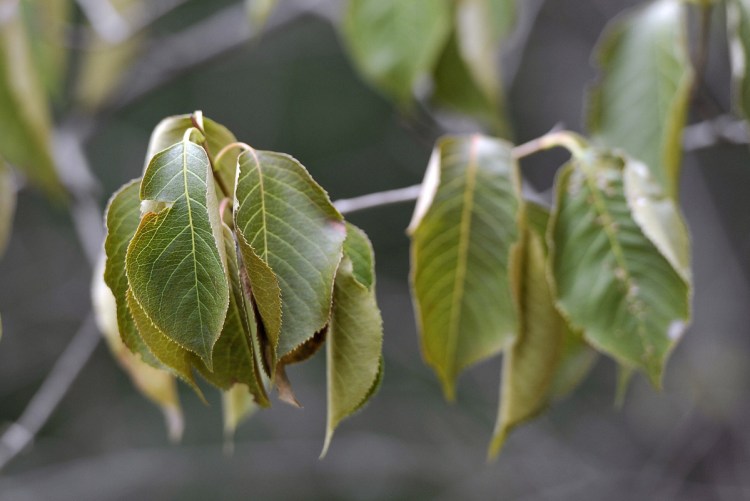The growing season seems to be repeating itself. For the third straight May – when gardening season begins to get serious – little rain has fallen. Only 0.79 of an inch of precipitation fell in Portland this May; the average for the month is 3.88 inches. As far as wells going dry and other major drought issues, this year is not as bad as 2016 (at least not yet), when the snowpack was scant and the low precipitation numbers started in winter and lasted until fall. The winter of 2017-18 had plenty of snow, and the ski season ran late. Until the end of April, Portland actually had more precipitation than average for the year.
Still, are dry springs the new normal? Is there any such thing as normal any more?
Those are questions far beyond what a retired journalist – one who writes about gardening and who knows only enough about weather to decide if he should water his plants – can competently answer. In addition, each year my memory of the past is getting foggier – to use a weather term.
For expert advice, I turned to Sean Berkel, a scientist specializing in climate change and ice sheet modeling at the Climate Change Institute at the University of Maine.
Climate is weather averaged over a long time, usually 30 years, Berkel said, although he prefers using 100-year increments. So three years of dry weather in Maine does not make this the new normal. What might be the new normal, however, is a longer period between rains.
“What has been documented over the past 10 to 15 years is an increase in the number of severe rainfall events,” Berkel said, with severe rainfall events defined as more than 2 inches of rain over 24 hours. If more rain is falling in severe events, it seems logical that more dry spells would occur between such events.
Two climatological conditions contribute to the increase of severe weather. One of the more popular theories, Berkel said, is that the disappearance of Arctic ice has created an upper-atmosphere jet stream with a wavier pattern. Another is that the increase in the surface temperature of the oceans puts more moisture in the atmosphere, causing severe weather events. A combination of the two may be to blame for more bad weather.
What does affect weather on a three-to-five year cycle is the effect of water temperatures in the Eastern Pacific Ocean, Birkel said. Warm seasons are El Nino and cool seasons are La Nina, and both can have an impact on weather across North America. But even those wouldn’t make dry weather in May a sure thing. In sum, it may feel like a pattern to the gardener who is tired of watering in May, but it’s probably a coincidence.
Birkel was one among a group of scientists who wrote the 2015 update of a 2009 report titled “Maine’s Climate Future.” A chart in that update shows that Maine’s rainfall actually has increased about 6 inches a year, or 13 percent, since 1895, “with most of the additional amount falling in summer or fall,” text with the chart says.
The chart also says Maine is expected to have its rainfall increase through 2050, which might be good news. Glen Koehler, a fruit-tree special with the University of Maine Cooperative Extension in Orono, in a talk at the Maine Agricultural Show in Augusta last January said the Northeast is one of the few regions where an increase in future rain is predicted.
Koehler’s talk was on how farmers should deal with climate change, and while this climate information is interesting, Maine farmers and gardeners want to know the practical information on how to produce healthy vegetables, sweet fruit and beautiful flowers in the face of changing weather.
I wrote a column on Koehler’s advice last winter, but to save you looking it up, I’ll summarize his ideas here.
• Put more organic matter in your soil. It helps retain water.
• Use more no-till methods so the heavy rainfalls don’t wash away your soil.
• Because heavy rains will wash away fertilizer, side-dress your crops with fertilizer through the season rather than fertilizing once at the start of the season.
• Create berms so soil won’t wash away in severe rainfalls and more soil will sink into the ground on your property.
These will probably be enough this year, at least in our Cape Elizabeth garden.
Even though the month has been dry, the rain barrels at our home are just now running dry. I’ve used the water in them mostly to water new transplants, newly seeded vegetables, the onion transplants and our many containers, which dry out quickly.
Although it hasn’t rained much, the temperature for the most part has been cool – so gardens haven’t dried out as quickly as they might have otherwise.
And if things get desperate, I will drag out the hoses. While I hate to pay the Portland Water District money for watering our plants, the advantage of being on public water, at least in Maine, is that it is always there. Sebago Lake won’t go dry in my lifetime.
ABOUT THE WRITER
TOM ATWELL is a freelance writer gardening in Cape Elizabeth. He can be contacted at: tomatwell@me.com.
Copy the Story LinkSend questions/comments to the editors.



Success. Please wait for the page to reload. If the page does not reload within 5 seconds, please refresh the page.
Enter your email and password to access comments.
Hi, to comment on stories you must . This profile is in addition to your subscription and website login.
Already have a commenting profile? .
Invalid username/password.
Please check your email to confirm and complete your registration.
Only subscribers are eligible to post comments. Please subscribe or login first for digital access. Here’s why.
Use the form below to reset your password. When you've submitted your account email, we will send an email with a reset code.